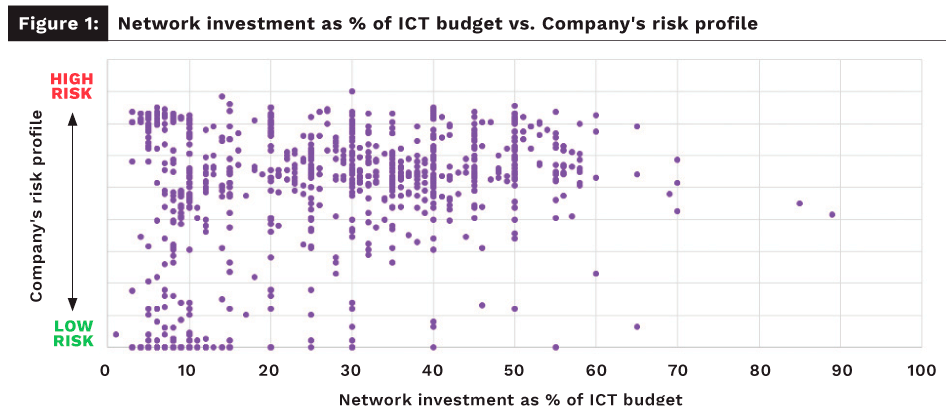By Jefferson Wang, Michele Marrone, and Swati Vyas
As Europe sets out to deliver on its second digital agenda, companies will need to equip themselves with a modern network that can enable next-generation technology solutions. However, our research shows that mere investment is not enough. Enterprises need to value modern network as the foundation of digital transformation, sync network strategy to C-Suite agenda, close the talent gap through creation vs. only recruiting, and most importantly refocus budget in favour of new modern networks instead of repairing legacy ones.
Key takeaways:
- More than half of European enterprises face issues with their legacy networks such as security breaches, high cost of deployment, inconsistent availability and low capacity.
- But spending on legacy networks maintenance will not work. Organisations will need to refocus investments on modern networks to enable the technology that will help European businesses maintain their global competitiveness.
- Also, our research shows that companies also need to tie their business results to technology roadmap and create the talent required, since the right network modernisation investments can drive innovation-led growth.
Europe is continually at the forefront of advancing the region’s digital infrastructure and accelerating the digital transformation of businesses. The first 10-year digital agenda for Europe (2010-2020) identified for the first time the key enabling role of information and communication technologies (ICTs) in reaching the region’s goals and setting out specific provisions to ensure a fair, open, and secure digital environment. Now, Europe is rolling out the second digital agenda (2020-30), setting itself challenging targets in various digital domains for 2030. It calls for advancements in areas such as quantum computing, blockchain, human-centric and trustworthy AI, semiconductors, digital sovereignty, cybersecurity, gigabit connectivity, 5G, and 6G. These are critical for the region’s digital transformation and to maintain its global competitiveness.
Modern connectivity is the foundation on which the realisation of this vision will rest. Companies across the globe acknowledge that a modern network is a prerequisite for transforming the business, enabling better outcomes for companies’ workforce, customers and partners. Our latest Accenture research “Modern networks: How to fast track competitive advantage in the digital future”1 shows that leading global companies are making sizeable investments in networks. European companies are spending close to 24% of their total IT budget to bolster network connectivity. Looking into the future, 73% plan to grow network investments by 6% or more during 2022-25, as compared to 46% during 2021-22. This aligns with the vision of Europe’s second digital agenda.
However, our research shows that these investments do not translate into improved network performance; more than half of European enterprise executives continue to face issues with their legacy networks, with a significant impact on the company. These include security breaches, high cost of deployment, inconsistent availability and low capacity. The impact of these network issues cascades across all business domains of an enterprise, leading to significant risk exposure.
Our analysis in Figure 1 shows that even companies investing a higher percentage of their ICT budget in network are still exposed to significant business risks attributable to network deficiencies.
About two-thirds of European enterprises in our study are exposed to risks in six areas: technology effectiveness, business efficiency, customer experience, workforce, trust and privacy, and sustainability. This means that network issues are not only obstacles to achieving business goals; they pose a significant risk in multiple domains.
Interviews with experts in European enterprises also confirm these challenges, which will only increase as businesses’ network requirements grow in the future. One of the executives said, “We’re in an urgent moment right now. We have a lot of aging network and wireless access points, and the need for bandwidth is going to be increasing for us within the next year. So, are we going to be able to meet that demand and is that going to have a negative impact on the service?”
So the question now is: If network spending is increasing, why is the network-associated company risk factor still so high?

The answer is that a majority of this investment goes towards the maintenance of legacy networks. Evaluation of the maintenance and modernisation budget for the last four years shows that while the share of investment in network maintenance activities is on the decline, the pace of change is too slow, and maintenance still accounts for almost half of the overall network budget of companies.
So, simply investing more is not the answer. Companies must refocus the budget in favour of new modern networks instead of repairing old, legacy ones. A good example of how a company benefited from flipping the budget in favour of new, modern networks instead of repairing old, legacy ones is that of British Sugar.
The company wanted to implement Industry 4.0 for better production efficiency. However, it soon realised it was not possible with ad-hoc legacy network fixes. Thus, in 2022, it decided to switch to a private mobile network, spanning multiple factory sites across a large geographical area. Wi-Fi could not be used as it presents challenges in an environment with a lot of metal: metal reflects, refracts or even absorbs wi-fi signals due to their frequency. The private mobile network not only helped the company mitigate Wi-Fi challenges but also provided other advantages such as:
- Dedicated and secure 4G connectivity for all British Sugar manufacturing facilities as part of a major ‘‘factories of the future’’ upgrade. Flexible and controlled mobile broadband connectivity in a complex factory setting with lots of metal.
- Facilitation of next-generation manufacturing techniques at its sites, including automated production lines, enhanced worker safety solutions, mobile asset tracking, autonomous guided vehicles and connected drones that can monitor tall structures such as silos and lime kilns remotely. This measures areas aimed at increasing productivity, boosting efficiency and improving health and safety on site.
- A future-ready network that is quickly upgradable to 5G. This will help British Sugar benefit from the higher speeds and lower latency of 5G while fully embracing the Industry 4.0 ecosystem, with more than 15 different digital manufacturing use cases in plan.
This approach of having a unified network strategy and dedicated investments in a modern network will result in several benefits, creating a significant impact across the enterprise.

First, reallocating budgets towards network modernisation reduces capital and legacy network operational costs. Continuing to invest in the maintenance of legacy networks, on the other hand, leads to a downward spiral of technology debt, limiting innovation and causing ad-hoc issues and security holes, thereby escalating overall legacy network costs. Investing in modernisation results in high-performing networks, which eventually reduces the resources tied up in managing tactical issues arising from legacy networks.
Our econometric analysis indicates that companies that shift spending away from maintenance of legacy systems see a decrease in their total annual network spend over the long run. Our modelling shows that a 30 percentage-point shift in spending away from the maintenance of legacy systems towards network modernisation over three years can help a typical company reduce its annual network spend by up to 21%. The specific reduction varies by industry, ranging from 12% to 21%, depending on the dynamics of capital and operational costs for each vertical industry.
Secondly, the right network modernisation investments can drive innovation-led growth in the future. We found that companies that shifted their network spend towards modernisation by 50 or more percentage points are 2.4 times more likely to be top industry spenders on innovation than their peers — the top 25% in an industry in technological innovation spend-to-revenues ratio. In essence, companies that shift towards modernisation are more likely to be the top innovators amongst their industry peers, assuming a top industry spender in innovation is a proxy for a top innovator.
While flipping the budget, enterprises need to align their strategy, technology and talent imperatives as well to transform their network from a position of tech debt to competitive advantage:
- Sync the network strategy with the C-suite agenda: The first step in modern network planning is to align a company’s network strategy with the overall vision of the business; network can be the anchor that helps companies achieve their business objectives.
- Create an elastic, configurable and consumable cloud-first network infrastructure: Software-defined, cloud-based architecture is the foundation of a modern network, as it enables flexibility and agility in network infrastructure and helps manage connectivity across multiple clouds. Automation and security are built on top of this cloud-first network infrastructure with unique benefits.
- Build future network talent and operational model enablers: For the full value of network transformation to be accomplished, modern network technical enablers should be closely intertwined with appropriate operating models and process transformation. It also requires a workforce equipped with modern network engineering skills either through training or by working with partners.
While the challenges surrounding network transformation may appear formidable, companies can progress on the network maturity journey by shifting budgets towards network modernisation and focusing on these three imperatives. A modern network will help businesses forge a path that will not only reduce capital and operational costs but also improve business resiliency and help them drive innovation-led growth in the future.
The authors thank Ramani Moses and Taniya Chandra from Accenture Research for their contributions to this article.
About the Authors
 Jefferson Wang is the lead author of the best-selling book, “The Future Home in the 5G Era.” He is Accenture’s Cloud First Global Technology Convergence Lead, focused on the harmonization of modern networks, edge, cloud, data, AI and security to create new user experiences and reinvent the back office. Jefferson is a regular speaker at Mobile World Congress (MWC) and Consumer Electronics Show (CES) and has appeared on CNN, CBS, NBC, ABC and Mobile World Live TV. His perspectives are featured in publications, including The Wall Street Journal, USA Today, Forbes, Fortune, New York Times and Washington Post.
Jefferson Wang is the lead author of the best-selling book, “The Future Home in the 5G Era.” He is Accenture’s Cloud First Global Technology Convergence Lead, focused on the harmonization of modern networks, edge, cloud, data, AI and security to create new user experiences and reinvent the back office. Jefferson is a regular speaker at Mobile World Congress (MWC) and Consumer Electronics Show (CES) and has appeared on CNN, CBS, NBC, ABC and Mobile World Live TV. His perspectives are featured in publications, including The Wall Street Journal, USA Today, Forbes, Fortune, New York Times and Washington Post.
 Michele Marrone is Accenture’s market lead for the Europe Cloud First Network organization which equips our cross-industry clients with next-generation products and services, including technologies like 5G, software-defined networking (SDN), network function virtualization (NFV), Edge Computing and Media Cloud—all which key enablers of the hyperscale revolution. He is part of the Europe Executive Committee for Communications, Media & Technology and ICEG Executive Committee. He was also in charge of the Mobility Managed Services Unit start-up within the Accenture New Business organization.
Michele Marrone is Accenture’s market lead for the Europe Cloud First Network organization which equips our cross-industry clients with next-generation products and services, including technologies like 5G, software-defined networking (SDN), network function virtualization (NFV), Edge Computing and Media Cloud—all which key enablers of the hyperscale revolution. He is part of the Europe Executive Committee for Communications, Media & Technology and ICEG Executive Committee. He was also in charge of the Mobility Managed Services Unit start-up within the Accenture New Business organization.
 In her role as research lead for the communications and media industry, Swati Vyas drives research and thought leadership across a number of topics in the industry. Having spent over 14 years in research, Swati has skills in thought leadership, next generation networks research, communications and media industry research, technology research, financial analysis and econometric value analysis. She has co-authored various Accenture thought leadership pieces. Two of her recent publications are “Modern networks: How to fast track competitive advantage” and “Start at the center: network-led transformation for growth.”
In her role as research lead for the communications and media industry, Swati Vyas drives research and thought leadership across a number of topics in the industry. Having spent over 14 years in research, Swati has skills in thought leadership, next generation networks research, communications and media industry research, technology research, financial analysis and econometric value analysis. She has co-authored various Accenture thought leadership pieces. Two of her recent publications are “Modern networks: How to fast track competitive advantage” and “Start at the center: network-led transformation for growth.”
Reference:
- Modern networks: How to fast track competitive advantage, 2023, Accenture, https://www.accenture.com/ch-en/insights/cloud/modern-network




































